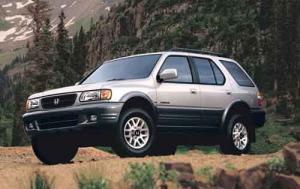- Save |
- Email |
- RSS |
- Newsletter
- Edmunds Review
- Consumer Reviews
- Features & Specs
- Safety
- Reliability

Used TMV from $5,661
Appraise Your CarFind 2002 Honda Passport Listings Near You powered by AutoTrader.com
What Edmunds Says
There are some good midsize SUVs available. This is not one of them.
Pros
Rugged good looks, roomy rear seat, Honda dealers will give one away if you push hard enough.
Cons
Poor ride quality, suspension not capable of serious boulder-bashing, front seats offer all the support and comfort of a lawn chair.
Available Models
Use the Edmunds Pricing System to help you get the best deal:
LX
- 3.2L V6 engine
- Automatic transmission
- Up to 15 cty/19 hwy mpg
- 4-wheel drive
EX
- 3.2L V6 engine
- Automatic transmission
- Up to 15 cty/20 hwy mpg
- 4-wheel drive
What's New for 2002
There are no significant changes to the Passport this year.
Review
The Honda Passport has been quietly going about its business for the past eight years. While the bulk of attention in the mid-sized sport-ute segment is directed toward the Ford Explorer, Toyota 4Runner, Dodge Durango and Nissan Pathfinder, the Passport has evolved to offer a combination of power, space and versatility that, if not compelling, at least comes in an attractive wrapper.
The Passport first arrived in 1993 as a re-badged Isuzu Rodeo, an arrangement that allowed Honda to get in on the hot SUV craze without engineering its own truck. In 1998, the Passport was completely redesigned. Still built by Isuzu in its Lafayette, Ind., plant, the Honda got bigger inside, more comfortable and more powerful.
The standard 205-horsepower 3.2-liter V6 makes 214 pound-feet of torque at a relatively low 3,000 rpm, providing enough get-up-and-go to satisfy most weekend warriors. But with no optional V8 engine available, the Passport compares poorly to other models in this class. Even the Pathfinder's V6 makes up to 250 horsepower.
The content-heavy base LX and dressed-up EX trim levels are available with two- or four-wheel drive. The 4WD transfer case is a shift-on-the-fly affair operated via a poorly located dash-mounted button. The Passport feels undersprung off-road and mushy on the highway, failing to please in either environment. Isuzu's Rodeo gets a driver-selectable suspension system to help in this regard, but doesn't share that particular toy with Honda.
Four-wheel-drive models get disc brakes at each corner, while rear-wheel-drive models get discs in front and drums in back. For safety, ABS and dual front airbags are standard on all models. Power windows, power locks, dual power mirrors, cruise, air conditioning and an eight-speaker stereo with cassette are also standard. The EX trim level adds a four-speed automatic transmission, foglights, interior woodgrain trim, leather-wrapped steering wheel, 16-inch alloy wheels, dual heated power mirrors, power moonroof and keyless remote entry. There's also a luxury package for the EX that includes a four-way power driver seat, leather upholstery and door panel trim, in-dash CD changer and two-tone paint with body side molding.
Fit and finish fails to live up to Honda standards, but most materials are of decent quality. You and your passengers will also appreciate the Passport's user-friendly ergonomics. Front seat comfort is lacking, but rear seats are roomy and supportive. With the backseat folded down, 81.1 cubic feet of cargo space is available.
Outside, the Passport is a handsome devil. Its square profile has the aspect of compact muscularity, making it a natural campsite companion. A luxury package-equipped EX, with its multi-spoked alloy wheels, two-tone paint and body cladding, is equally well suited to carry you to the opera.
Competitors in this segment get all the attention for a reason. Considering that we've had less than stellar experiences with the Passport and Isuzu Rodeo, and considering that J.D. Power and Associates' names the Passport one of the poorest quality vehicles sold, we recommend shopping for something else. Even if that something else is a Rodeo, which comes with a far superior warranty package.
Research Models
Advertisement
Advertisement
Used Car Resources
Advertisement
Recently Viewed
 View photos
View photos